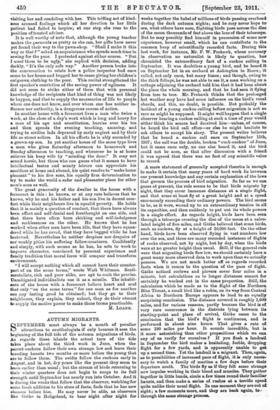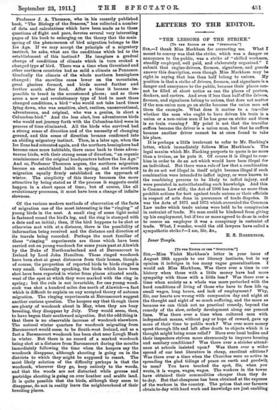AUTUMN MIGRANTS.
SEPTEMBER must always be a month of peculiar attractions to ornithologists if only because it sees the beginning of the full tide of the autumn migrations of birds. As regards these islands the actual turn of the tide takes place about the third week in June, when the parent cuckoos follow their own strange law and leave their breeding haunts two months or more before the young that are to follow them. The swifts follow the cuckoos early in August, and in hot, dry years like the present they seem to lease earlier than usual ; but the stream of birds returning to their winter quarters does not begin to surge to its full strength until September has nearly run into October. And it is during the weeks that follow that the observer, watching for some fresh addition to his store of facts, feels that he has new chances before him. He may never be able, as observers Eke Gatke in Heligoland, to hear night after night for SEPTEMBER must always be a month of peculiar attractions to ornithologists if only because it sees the beginning of the full tide of the autumn migrations of birds. As regards these islands the actual turn of the tide takes place about the third week in June, when the parent cuckoos follow their own strange law and leave their breeding haunts two months or more before the young that are to follow them. The swifts follow the cuckoos early in August, and in hot, dry years like the present they seem to lease earlier than usual ; but the stream of birds returning to their winter quarters does not begin to surge to its full strength until September has nearly run into October. And it is during the weeks that follow that the observer, watching for some fresh addition to his store of facts, feels that he has new chances before him. He may never be able, as observers Eke Gatke in Heligoland, to hear night after night for
weeks together the babel of millions of birds passing overhead during the dark autumn nights; and he may never hope to see, what others have seen, fighting birds pass across the disc of the moon thousands of feet above the lens of their telescope. But he may possibly find himself in possession of some new experience, however small, which he can contribute to the common heap of scientifically recorded facts. During this last week, for instance, Mr. F. W. Frohawk, whose accuracy' in observation no naturalist is likely to question, has chronicled the extraordinary fact of a cuckoo calling in September. It was doubtless a young bird, and he heard it on September 1st in an orchard at Ashington in Essex ; it called, not only once, but many times ; and though, owing to the thick foliage, he was not able to see it, a man working on a cottage adjoining the orchard told him that it had been about the place the whole morning, and that he had seen it flying from tree to tree. Mr. Frohawk thinke that the prolonged hot weather may have had some influence on the bird's vocal chords, and this, no doubt, is possible. But probably the incident of a young cuckoo calling before migration is not so rare as might be supposed. It might well happen that a single observer hearing a cuckoo calling at such a time of year would either think his senses had deceived him—unless, of course, he heard the bird call often—or else be might hesitate to ask others to accept his story. The present writer believes that he heard a cuckoo call once on September 15th, 1907; the call was the double, broken " cuck-cuckoo" of June, but it came once only, no one else heard it, and the bird could not be seen, so that after discussion with a friend it was agreed that there was no fact of any scientific value to record.
A mere statement of generally accepted theories is enough to make it certain that many years of hard work lie between our present knowledge and any certain explanation of the laws that govern the process of bird migration. So far as we can guess at present, the rule seems to be that birds migrate by night, that they cover immense distances at a single flight, and that some at least fly at a great height and at a speed enormously exceeding their ordinary powers. The bird seems to be, as it were, wound up to an extraordinary tension in all its capacities, and then suddenly to put out its whole powers in a single effort. As regards height, birds have been seen through a telescope crossing the disc of the moon at a calcu- lated height of five miles, and Gatke believed that some birds, such as curlews, fly at a height of 10,000 feet. On the other hand, birds have been observed flying in vast numbers low over the sea, and there are many recorded instances of flights of rooks observed, not by night, but by day, when the birds were at no greater height than usual. Still, if the general rule were that migrating birds flew low, we should certainly have a great many more observed data to work upon than we actually possess. We are not much better off as regards recorded facts when it comes to the question of the pace of flight. Gatke noticed curlews and plovers cover four miles in a minute, but calculations as to longer distances cannot for certainty be worked out in the same proportion. Still, the calculation which he made as to the flight of the Northern Blue Throat, a small bird like a robin, on its way from Central Africa to Northern Europe appears to lead to an equally surprising conclusion. The distance covered is roughly 1,600 miles, and for various reasons, partly because the bird is of very rare occurrence in the districts lying between its starting-point and place of arrival, Gatke came to the conclusion that the bird's flight is continuous, and is performed in about nine hours. That gives a rate of some 180 miles per hour. It sounds incredible, but is it more astonishing than other propositions which we can any of us verify for ourselves ? If you flush a lamina]. in September the bird makes a hesitating, feeble, dropping flight for a few yards, and is apparently unable to gob up a second time. Yet the landrail is a migrant. Then, again, as to possibilities of increased pace of flight, it is only neces- sary to watch a family of martins a few days before their departure south. The birds fly as if they felt some strange new impulse working in their blood and muscles. They gather together in little bands, circle a few times round their familiar haunts, and then make a series of rushes at a terrific speed quite unlike their usual flight. In one moment they are out of sight ; a few moments more, and they are back again, to / through the same strange process. Professor J. A. Thomson, who in his recently published book, " The Biology of the Seasons," has collected a number of data and calculations which have been made as to these questions of flight and pace, devotes several very interesting pages of his book to enlarging on the theory that the main spring of the phenomenon of bird migration belongs to the Ice Age. If we may accept the principle of a migratory instinct, be asks, what are the conditions which led to the establishment of this instinct P He imagines a gradual change of conditions of climate which in turn evoked a changed type of bird. There was a time when Greenland and other northern countries had as mild a climate as Penzance. Gradually the climate of the whole northern hemisphere changed : the snowline came lower on the mountains, great glaciers formed, and birds moved further and further south after food. After a time it became im- possible to breed in the accustomed places; and so there arose a new and revolutionary type of bird to meet these changed conditions, a bird " who would not take hard times lying down, who was sensitive, alert, restless, unconventional, adventurous, and original, who was a genius, in short a Columbus-bird." And the less alert, less adventurous birds who would not journey forth with the Columbus-bird were in process of time eliminated. All the birds who survived had a strong sense of direction and of the necessity of changing ground, and this sense of direction became confirmed into an abiding migratory instinct. Then, in a later age, when the Ice Zone had retreated again, and the northern hemisphere had become once more habitable, there came back to these adven- turous birds, with their strong sense of direction, "an organic reminiscence of the original headquarters before the Ice Age." And so, Professor Thomson argues, the northern migration became an established habit in spring, and the southern migration equally firmly established on the approach of winter. The simplicity of this theory becomes the more attractive by being stated as if the process it suggests could happen in a short space of time; but of course, like all evolutionary processes, it must have been a change of infinite slowness.
Of the various modern methods of observation of the facts of migration one of the most interesting is the " ringing " of young birds in the nest. A small ring of some light metal is fastened round the bird's leg, and the ring is stamped with a date and an initial; then, if the bird happens to be shot or otherwise met with at a distance, there is the possibility of information being received and the distance and direction of its travels being recorded. Perhaps the most familiar of these " ringing " experiments are those which have been carried out on young woodcock for some years past at Alnwick by the Duke of Northumberland and at Baronscourt in Ireland by Lord John Hamilton. These ringed woodcock have been shot at great distances from their homes, though. of course, the proportion of reported birds to birds ringed is very small. Generally speaking, the birds which have been shot have been reported in winter from places situated south. west of the spot at which they were marked with the ring in spring ; but the rule is not invariable, for one young wood- cock was shot a hundred miles due north of Alnwick—a fact which is difficult to explain on any accepted theory of autumn migration. The ringing experiments at Baronscourt suggest another curious question. The keepers say that though there are plenty of woodcock about in May, when they are busy breeding, they disappear by July. They would seem, then, to have begun their southward migration. But the odd thing is that there is no observable increase of woodcock elsewhere. The natural winter quarters for woodcock migrating from Baronscourt would seem to be South-west Ireland, and as a fact a Baronscourt woodcock has been shot near Lough Mask in winter. But there is no record of a marked woodcock being shot at a distance from Baronscourt during the months immediately following the time when the keepers say the woodcock disappear, although shooting is going on in the districts to which they might be supposed to resort. The most likely solution of the difficulty perhaps is that the woodcock, wherever they go, keep entirely to the woods, and that the woods are not disturbed while grouse and partridge shooting is going on over heather and arable land. It is quite possible that the birds, although they seem to disappear, do not in reality leave the neighbourhood of their breeding places.







































 Previous page
Previous page